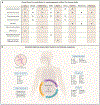The tumor mycobiome: A paradigm shift in cancer pathogenesis
- PMID: 36179665
- PMCID: PMC10189653
- DOI: 10.1016/j.cell.2022.09.013
The tumor mycobiome: A paradigm shift in cancer pathogenesis
Abstract
Distinct fungal communities or "mycobiomes" have been found in individual tumor types and are known to contribute to carcinogenesis. Two new studies present a comprehensive picture of the tumor-associated mycobiomes from a variety of human cancers. These studies reveal that fungi, although in low abundance, are ubiquitous across all major human cancers and that specific mycobiome types can be predictive of survival.
Copyright © 2022 Elsevier Inc. All rights reserved.
Conflict of interest statement
Declaration of interests X.L. and D.S. are co-founders of PeriomicsCare LLC.
Figures

Comment on
-
Pan-cancer analyses reveal cancer-type-specific fungal ecologies and bacteriome interactions.Cell. 2022 Sep 29;185(20):3789-3806.e17. doi: 10.1016/j.cell.2022.09.005. Cell. 2022. PMID: 36179670 Free PMC article.
-
A pan-cancer mycobiome analysis reveals fungal involvement in gastrointestinal and lung tumors.Cell. 2022 Sep 29;185(20):3807-3822.e12. doi: 10.1016/j.cell.2022.09.015. Cell. 2022. PMID: 36179671 Free PMC article.
References
-
- Hanahan D (2022). Hallmarks of Cancer: New Dimensions. Cancer Discov. 12, 31–46. 10.1158/2159-8290.cd-21-1059. - DOI - PubMed
Publication types
MeSH terms
Grants and funding
LinkOut - more resources
Full Text Sources
Medical

